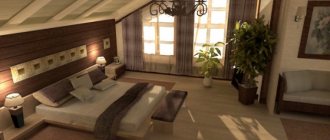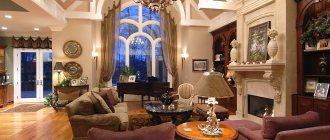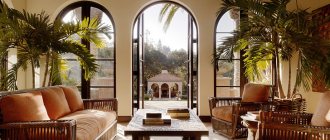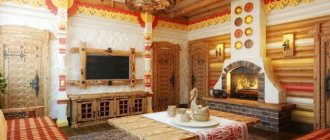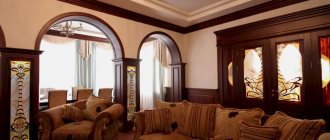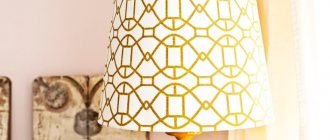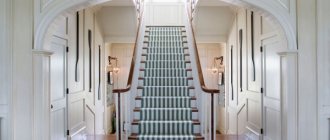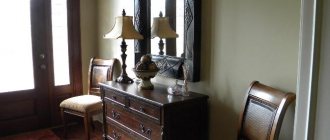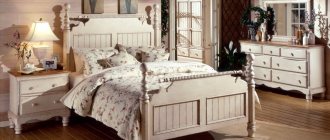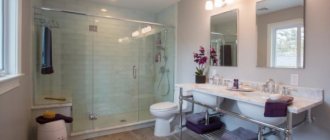In the East, it is customary to pay main attention to the interior decoration of a home rather than its façade. An inexperienced guest hurries to hide from the midday heat in the shade of the gray walls of a hospitable house, passes the open doors, pulls back the embroidered curtains, and for a moment is speechless, amazed by the sudden change.
A luxurious room appeared before my eyes, like another world, whose interior decoration was comparable to a scattering of precious stones, and the desired rest was refined, like the touch of cool silk on a weather-beaten cheek. This is an oriental style living room.
Oriental and Arabic, Persian and Turkish style. All these names share similar interior solutions typical of the Middle East.
These words are immediately associated with the lush chambers of sheikhs and caliphs from Arabian tales. Bright multi-colored carpets, the soft light of numerous lamps playing on the intricate curves of gold forging, exciting shadows of richly embroidered brocade and silk draperies.
The culture and way of life of the East for European people to this day remains exotic, captivating with its unusualness and strength, filled with bright and rich colors, splendor and the embodiment of sybaritism.
Decorating rooms and living rooms in oriental style, due to its special flavor, is not such a common occurrence.
Therefore, with a professional and creative approach, such a living room becomes a unique work of art, very individual, while maintaining its main purpose - convenience and functionality.
Are you planning to renovate your living room? Take a look at the photo with examples of wallpaper combinations in the living room. They will help you choose a good interior solution.
And one more article that will help you choose wallpaper for the living room -.
The Provence style living room is completely different from the examples presented here, but perhaps it might interest you.
Style Features
The main features of the oriental style are the widespread use of fabrics, contrasting rich colors, an abundance of embroidery, patterns and ornaments, ornate fluidity of lines and contours. The Big East doesn't like straightforwardness at all.
The exception is the ascetic Japanese style, but asceticism brought to perfection is also a masterpiece.
The same smoothness of lines is preserved in eastern architecture, replete with high lancet windows, arches with carved archivolts, and an openwork and multi-colored colonnade.
At the same time, the dimensions of the interior spaces are completely different - from huge halls with vaults going up to small cozy chambers, decorated with carpets. Therefore, the oriental style of decorating a living room is equally suitable for both a large spacious hall and small rooms.
Palace in the room
The architecture of the Persian East is replete with pointed window openings, arches and semi-arches with carved contour design - archivolts . A good solution would be to install an arched opening into the room next to the living room in exactly this style.
You can use moldings to create framed areas on the walls that imitate lancet windows and arches.
A shallow niche of this shape with hidden lighting will allow you to place objects and souvenirs typical of the East in it, and will focus attention on them.
Several narrow pointed structures on one wall will visually increase the height of the room, serve as a place to place panels, or they themselves can become “frescoes” due to the use of decorative materials within the outline that differ in color and texture.
Imitation of arched and lancet openings, the use of stucco half-columns will allow you to zone the living room, fit the dimensions of the selected furniture into the interior and create additional comfort.
In rooms with high ceilings, it is good to use ceiling skirting boards and cornices with or without hidden lighting. Complex oriental patterns look better on wide, massive cornices, so this solution is not suitable for standard ceiling heights.
For low rooms, you can arrange a ceiling structure from dark wooden slats that imitate beams. In the interbeam cells you can place flat lampshades decorated in the Arabic style.
If the room is of irregular shape, the room has load-bearing columns, beams, different ceiling heights and other structural elements that need to be played out, then for an oriental-style design this is not an obstacle, but a success.
Light metal or wooden structures with a through ornament will frame a banal square pillar and turn it into an eastern column, and the protruding corners suggest decorating them with molded decor made of wood or stucco, or will serve as anchor points for zoning arches, screens and screens.
A large difference in ceiling heights (for example, in the attic floor) does not always allow the use of standard furniture. And often it is impossible to simply come close to the wall due to the low ceiling height. But such a niche would fit perfectly into a wide and low sofa-ottoman, or just a thick mattress placed directly on the floor. You can climb onto it very comfortably and very orientally with your feet, lean on the numerous pillows and feel like a caliph on vacation.
For rooms with curved walls, an original move would be to use a thick hemp cable coated with varnish and aged bronze instead of a floor plinth. In the same way, you can fit the electrical cords of floor lamps into the interior by disguising the wire with textile braiding and “old bronze.”
Interior in Turkish style
Today, Ottoman-style interiors are gaining popularity. A room or recreation area is allocated for him. After all, the very atmosphere of the situation is conducive to this. The carpets are silk and wool with original designs, which can be used to identify the area where they were made. Bolsters, embroidered pillows, canopies and bedspreads will help create the atmosphere of the East.
Lay out the carpet, choose pillows and bolsters to match. Place a hookah nearby. A low table with a bowl of fruit on the table will be a wonderful addition to the decor. Use curtains of appropriate colors to create twilight. Canopies will create a romantic mood and add mystery.
Armandi studio specialists have traveled a lot around the world and will help you choose curtains and cornices to create an authentic oriental flavor in your home.
Walls
The walls of an eastern home were traditionally covered with carpets and draped with fabrics. Nowadays, wallpaper with a bright pattern reminiscent of embroidery in gold, silver or beads, silk-screen printing, and wallpaper with a textile structure are suitable for this purpose.
The colors should be rich and, most importantly, natural. “Modern” shades that resemble painted plastic, neon and similar paints cannot be used.
Preferred colors for oriental style:
- red in any variation;
- ocher from pale to rich;
- cream, peach;
- shades of green, turquoise, pistachio;
- pearl grey.
In each case, the choice of color is individual, but it is very advisable to combine colors. For example, for the living room walls in a lushly aggressive Persian style, alternating wide stripes of burgundy-red wallpaper with gold and silver threads, and light ocher wallpaper with a moire pattern were used.
The living room, in a more relaxed Moroccan style, featured pistachio-colored striped wallpaper with embossed floral patterns, alternating with wallpaper reminiscent of smoky marble. It gave the impression of a pleasant, relaxing coolness, as if it were a sultry eastern afternoon outside the windows.
Oriental style ceramic tiles
Specialization: ceramic tiles and sanitary ware in interior design. The company was founded in 1995 and is currently a major importer of ceramic tiles on the finishing materials market. Our suppliers are leading European manufacturers, including ROCERSA, NOVOGRES, DIAGO, CERAMICA MAYOR, ARANDA and many others.
has a chain of stores in Moscow and regularly exhibits its products at specialized construction exhibitions. The constantly growing dealer network today is represented by companies from Moscow, Saratov, Vologda, Voronezh, Yaroslavl. In stores, products are presented in the form of ready-made interior corners, which makes it easy to make a choice.
At the moment, it is entering the market with a direction of ceramic tiles that is fundamentally new for Russia - these are oriental-style tiles with unusually beautiful Arabic and Muslim ornaments.
This ceramic tile was first used as a building cladding material in Persia and Mesopotamia.
Over the centuries, Arabic ceramic mosaics, brought there by the Arabs, became widespread on the Iberian Peninsula. On the territory of the Iberian Peninsula, large-scale production of ceramic mosaics is being established due to the fact that the Arabs used it with extraordinary intensity in construction.
Local artisans managed to create a new style of ceramic tiles, reflecting the influence of the East and the traditional patterns of the Iberian Peninsula.
Ceramic tiles, handmade by artisans in the Mozarabe style, are extremely popular in Spain.
Thanks to the widespread use of tiles, cities such as Seville, Valencia, Zaragoza, Toledo, etc., are forming their own individual style and appearance.
The facades of buildings and courtyards are tiled with various types of tiles using geometric, symmetrical and floral patterns.
To define this style of painting and laying out tiles, the term “Sevillano” is most often used, since in Seville the use of the above-described type of tiles for both interior and exterior decoration of buildings is most clearly represented.
However, experts prefer to divide such tiles into two subgroups. To define the facades of buildings tiled using geometric, symmetrical, typically Arabic, Muslim patterns, the term “Arab mosaic” is used, while tiles with floral patterns are defined as “Sevillano”.
The most valuable and high-quality tiles are still produced by hand, but modern manufacturers (owners of small factories) are trying to combine the traditions of tile making with new production technologies.
Just like in the days of handcraft, modern manufacturers continue to attach great importance to every detail. With the use of modern production technologies, manufacturers began to achieve impeccable quality for each individual tile.
Particular care in production over time allowed the manufacturer to achieve perfection in the color scheme, inspiring the decorator to create original interiors. This is confirmed by the fact that our tiles are used in the design of buildings on five continents of the world.
At each stage of production, the tiles undergo strict quality control, which guarantees the perfect processing of the product. Much attention is paid to the selection of the best ceramic blanks, which are exposed to thermal effects at temperatures of about 1000 degrees Celsius.
Then professional artisan artists begin the process of painting the tiles, using their talent and imagination. The moment comes for reproducing old traditional patterns and creating new ones, after which the tiles undergo a final firing at a more moderate temperature and acquire a glassy shine effect. The product is considered ready for sale only after passing the last stage of quality control.
Arabic mosaics create a feeling of freedom of space that combines flora, water and light, creating a harmonious and calming atmosphere reminiscent of ancient Arab palaces.
Sevillano tiles are ideal for a variety of interiors: hotels, offices, residential premises, theater halls, shop windows, exhibition halls, etc. This tile will create an unusual, special color and atmosphere of warmth and comfort.
It should be noted that the staircase is a very suitable architectural element for playing with the symmetry of shapes and perspectives that form a beautiful Arabic mosaic.
When decorating fountains, a transparent curtain of water effectively emphasizes the rich colors of the mosaic.
The Arabic and Sevillano style plinths are the epitome of elegance in color and design. Tiles of this style are popular in all corners of the world and can complement both classic and modern interiors. It is used for external and internal decoration, used in spacious and small rooms. And, of course, traditionally the tiles described above are used to decorate the kitchen and bathroom.
Furniture - unusual and comfortable
A Turkish or Persian living room must have at least one sofa. Upholstered, with a wide seat and armrests, richly embroidered upholstery, and carved wooden elements.
Near the sofa, preferably on a spread carpet, there should be a low table. Best option: dark carved wood. The tabletop can be inlaid with mosaics or made of dark glass.
Shelves, chests of drawers and cabinets should be made of natural materials or good imitation. The height of the cabinets is small. Furniture “to the ceiling” was not used in the East.
No less obligatory attribute are soft cushions, numerous pillows and cushions, embroidered with ornaments, beads, decorated with fringe and tassels. Some of the pillows can be placed directly on the floor, as is customary to sit in the East.
Wicker furniture and light wood furniture will be appropriate for an Indian-style living room. You should not use such furniture in a Middle Eastern living room.
The highlight of the furniture can be a piece of furniture with a strong oriental touch. For example, carved wooden hexagonal stool benches. The hookah table is of the same shape, with an ornament reminiscent of Arabic writing.
Curtains and drapery
Fabric motifs of oriental style are especially well emphasized by correctly selected curtains.
Oriental curtains are a complex composition of lambrequins, movable and fixed curtains, fringe, plaits and tassels.
Lambrequins will allow you to change the light openings of windows, making them pointed or arched. Long, floor-length curtains should be in harmony with the overall color ensemble.
In the multicolored oriental style, it is difficult to choose curtains to match the color of the walls. The best solution would be to choose curtains that match the color of the upholstery of upholstered furniture and pillows.
However, the reverse approach can also be used. The bedspread on the sofa and armchairs, as well as covers for several pillows, were made of fabric identical to the main material of the curtains.
Curtains should embody the luxury and pomp of the oriental style. The most suitable fabrics for this are silk and brocade.
The fabric can be one color, since the pattern will be difficult to see in numerous folds. But the color must certainly be bright and rich.
It will look interesting if from several windows the fixed part of the curtains continues to the ceiling, gathering to some logical center. The result is a structure similar to a canopy.
In general, when decorating a living room in an oriental style, you should not skimp on fabric elements, curtains and drapery. The more textile elements of the interior, the closer the result will be to the historical original.
It must be remembered that lush curtains made of heavy fabrics visually make the room smaller. For small living rooms it is better to use combinations of silk and organza.
A living room in a Scandinavian style is completely different from an oriental one. Strict straight lines. A combination of two or three colors in the interior. Lack of luxury and pomp. Interesting?
Do you like bright rooms? Living room in beige tones: photos and examples of interiors in our article - https://flaterra.ru/gostinaya/dizain-g/cvet-g/v-bezhevykh-tonakh-foto-i-sovety.html.
Here are examples of living room design in white - https://flaterra.ru/gostinaya/dizain-g/cvet-g/interer-v-belom-cvete-foto-idei.html.
Features of the choice of finishing materials for an oriental interior ↑
An unusual solution for exotic lovers
A national costume will look ridiculous if it is made from fabric that has nothing in common with the traditions of the people. The choice of finishing materials for arranging a room in a certain style is no less important. For the eastern direction, mosaics or small ceramic tiles are ideal. Traditionally, tiles with symmetrical patterns or repetition of identical small details are used for wall decoration.
Decorative arch in the washbasin area
For the ceiling, it is recommended to use a stretched PVC fabric with a characteristic oriental pattern, gold streaks or flowers. If the height of the room allows, then the national flavor can be emphasized with an arched ceiling, characteristic of the Moroccan direction. A carpet made of ceramic tiles, “woven” from intricate weaves or a repeating pattern, will look great on the floor.
Stylish fusion of East and West
The color palette of finishing materials can be bright and rich, characteristic of the Arabic style, or restrained, characteristic of Asian minimalism. If you like rich colors, preference should be given to warm shades: yellow, brown, green, orange, terracotta, blue, pink. In small rooms, pale blue patterns on a white background will look more appropriate.
Luxury for connoisseurs of rich ethno
Lighting - a play of light and shadows
Oriental style lighting should not be harsh or overly bright. Soft light will emphasize the mystery and some intimacy of the East, creating a cozy and relaxing atmosphere.
The central lamp familiar to living rooms can be either a hanging multi-tiered chandelier or a large matte lampshade.
Again, combinations of light colors and light-refracting details, and dark wood elements, bronzing, gilding, floral and geometric patterns are used.
The main lighting design technique for the eastern living room is spot and zoned lighting using wall and floor lamps with thick fabric or paper lampshades that diffuse the light.
An ideal, but difficult to implement solution would be to select and combine all wall and floor lamps into a single ensemble and turn them on at the same time.
In this case, the central ceiling lamp is not used at all, remaining, as it were, redundant.
For individual spot illumination of individual zones (for example, for ease of reading), you can use table lamps. These lamps become decorative elements, so special attention should be paid to their compliance with the overall style.
Characteristic features of the style
The concept of “oriental style” can be represented by several cultures of Asian and Arab countries (Morocco, India, Turkey, Iran, Japan, China), each of which has its own specific features and characteristics.
Homely atmosphere
Characteristic features of the interior in oriental style:
- bright colors and contrasting tones that are used to decorate walls, ceilings, furniture and decorative items (primary colors - yellow, turquoise, scarlet);
- there are no straight lines and surfaces;
- high vaulted ceilings;
- the design includes a lot of wooden decorative items with carvings and ornaments;
- much attention is paid to textiles in furniture upholstery, draperies, many carpets, pillows, multi-layer drapes and curtains;
- Decorative items made of ceramics, mosaic elements, and handmade embossing are highly valued;
- play of light and its abundance.
Features high ceilings
The difference between the Asian style is its minimalism, i.e. the room should have a minimum amount of furniture and decor, but the lighting should be maximum . In Chinese interiors, bright colors (red, yellow, blue) are welcomed, while in Japanese interiors, only a restrained range of colors is allowed when decorating.
Accessories
It is difficult to imagine an oriental room without small household items, souvenirs and dishes. Boxes, figurines, hookahs, vases and jugs, chased or carved, must be present.
It should be noted that images of people are unacceptable for Middle Eastern culture, therefore there are no portraits or sculptures of people in the Arab interior. But there is plenty of carving, ornaments, inscriptions in Arabic script, mosaics, embroidery with metal thread and beads.
The choice of decorative accessories should be approached carefully.
The cultural traditions of the East are different. For example, a vase with hieroglyphs in a Turkish-Persian interior will spoil the overall harmony. Hookah cannot coexist with Buddhist symbols. There should be no cutting-edge details, even accidentally left on a shelf or table.
The East gravitates towards order no less than luxury.
Photo examples
The oriental living room in the Arab-Persian style is finished and ready to receive the enthusiastic and approving glances of guests.
The sofa invites you to relax, surrounded by colorful pillows. Soft light plays on the golden embroidery and embossing, getting lost in the exciting shadows of the curtains. An old jug with an incomprehensible inscription in Arabic script just makes you want to rub it - what if!
But the main and main advantage of the oriental living room, with all the dazzling colorful luxury, is not a museum. This is home. The living room is cozy, light, relaxed and comfortable.
Oh, these eastern rulers knew a lot about comfort!
